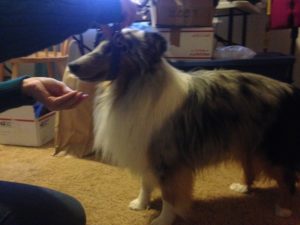There are a lot of dogs, even those who have never been abused or corrected, that do not like to have their collar put on. It can become a terrible cycle of you chasing your dog to catch him–possibly dragging him out from under a bed or from behind something by his fur–and then restraining him while you (or someone else) struggles to get the collar on without getting bit. I have known people that never took their dog’s collar off, even for baths, because they would not be able to get it on again.
Stop Chasing
First off, you need to stop the cycle. Stop chasing, dragging, and restraining. All this is doing is creating even more reasons for your dog to not like putting on his collar. If someone did that to you every time you needed to put your coat on, would you come to it joyful? No.
Start Training
Next, you need to start training. The best way to make the collar a good thing is to turn it into a trick. The dog training facility I used to work at called it “get dressed,” which I think is just adorable. But, you could call it whatever you want.
The words aren’t what matters. What matters is that we are going to teach your dog to come running to you and put his head through his collar or harness willingly and happily.
Don’t believe me? Try it, it works.
Teaching Get Dressed
Here are the instructions for teaching this. Depending on how head shy your dog is, it may take a day or two, or it make take weeks. Move at your dog’s speed in order to be successful.

Also, in the case of collars (vs. a harness: using a martingale collar is easiest because you don’t have to worry about fussing with a buckle and your dog can’t back out of it. Also, for some dogs, the click of the buckle is part of what bothers them about the collar.
- Start in a small room where your dog can’t get too far away from you. If you can, sit on the floor with your dog to make the scene more relaxed. Have plenty of good treats and his collar.
- Leave the collar on the floor and mark/reward (M/R) your dog every time he approaches the collar or touches it. (kind of like a nose touch with the collar as the target.
- When your dog is deliberately going up to the collar, pick it up and hold it so the big loop (where his head will go) is fully extended. M/R your dog for touching the collar in this new position.
- Then, start delaying your M/R and see if your dog will start to nose the collar more. Eventually he will accidently put part of his nose through the center. M/R BUT DO NOT PUT THE COLLAR ON ALL THE WAY RIGHT NOW.
- Instead, remove it and start again.
- Repeat, upping the criteria as your dog is comfortable, until your dog is pushing his entire head through the collar on his own.
- Once he doing this, you are going to have to work on getting the collar off. Most dogs that are collar shy, also back quickly out of the collar and then run. So, as you start to take the collar off, stop any time your dog starts to back his head or body up. When he is still, continue to remove the collar. This takes patience, but it does work. Eventually your dog will stand still while you pull the collar off.
- Once your dog is putting his collar on by himself, it’s time to start adding distance. Hold the collar several inches away and see if he will walk to put the head through, M/R when successful. Then try a foot or two.
- When he will move to put his head through, you can put it on cue if you wish (the collar being held up can be the cue, or you can use a verbal, like “get dressed”). Do this by saying the cue as your dog puts his head through the collar.
TIP: Standing behind or to the side of the dog, instead of in front, can help your dog be less wary of the collar.
Note on buckles: If you are using a buckle collar, you may find it easier to have two people – one to buckle and one to treat in the beginning. One person will hold open buckle collar up for dog to come and place chin on, other will M/R. Eventually, when he is coming up, laying his head on the collar for you to buckle in one fluid motion and then be rewarded, you will no longer need two people.
About the Author
Based in Wilsonville, Ore., animal lover Kristina N. Lotz is a Certified Professional Dog Trainer – Knowledge Assessed (CPDT-KA) and works as a full time trainer. She is the founder of A Fairytail House, a unique all-positive all-sport dog training facility that helps rescue dogs in her area and provides free seminars and training classes for the community. In her spare time, she trains and competes in herding, agility, obedience, rally, and conformation with her Shetland Sheepdogs. She smartly married a Veterinary Technician, who helps keep the fur kids happy and healthy, and provides a quick resource for articles.
